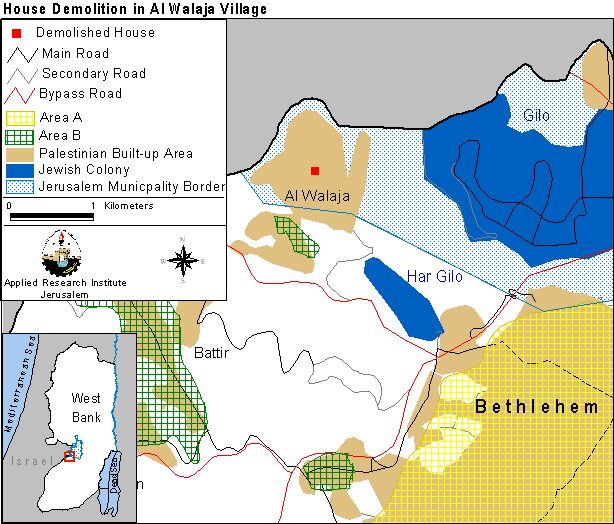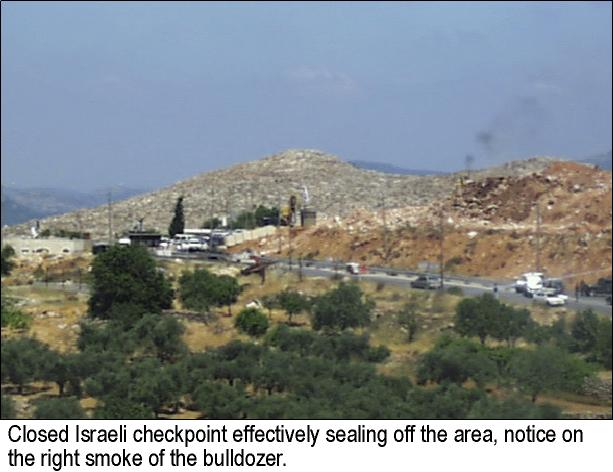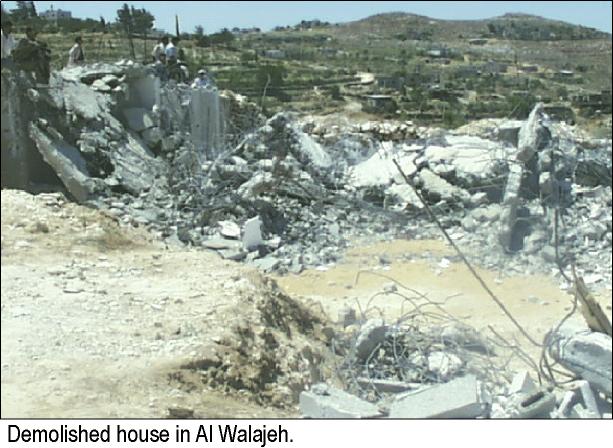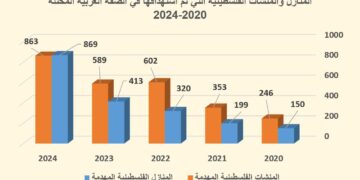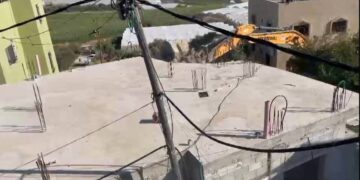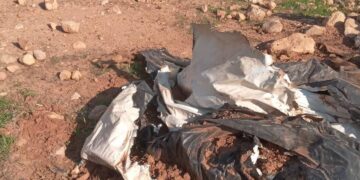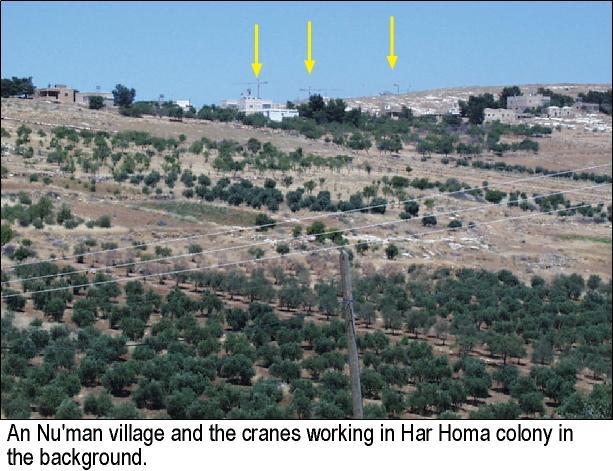Al Walaja is a village lying about 4 kilometers northwest of Bethlehem. The village used to be farther west but Israeli forces completely destroyed it after the 1948 war. So the villagers resettled on the opposite side of the 1949 Armistice Line (green line) only to be reoccupied by Israel in 1967. Today around 2500 of the original inhabitants still live in this area. However their misery does not end here. The Israeli authorities included parts of the new Al Walaja to the unilaterally expanded Jerusalem borders in 1967 and have harassed the Arab inhabitants ever since. The villagers have had to endure closures, rejection of building permits, denial of basic municipal services and, most of all, the demolition of homes (see map).
In the morning of 5th of June 2000 Israeli troops (Border Guards, Special Forces and Israeli Police) sealed off the village and came in with bulldozers (see photo). They were heading for Hasan Shhadah Khalefa's house. They came to demolish it. Hasan asked if he could take his furniture out but was kept away from his house. While the bulldozers did their work, clashes occurred between the villagers and Israelis injuring eight Palestinians and seven Israeli soldiers. The demolition of the house was finished around ten and after destroying part of the access road, an irrigation-pipeline and uprooting some trees, the Israeli authorities declared the area open again. Eighty houses and one mosque are still under threat of demolition in Al Walaja (see photo).
Hasan Khalefa, a 38-year-old construction-worker, had finished building his 170 square meter house in 1999. He spent $40,000 building his one floor house, containing four rooms, a kitchen and a bathroom. Until today, he lived there with his wife and eight children in peace on his own two-dunum land (0.2 hectare). Thirty days ago he got a notice from the Israeli Authorities that his house would be demolished because it was build without a permit. Hasan had applied for a permit but it was denied, as is the case for all Palestinians living in area C. More background information:
http://www.amnesty.org/ailib/aipub/1999/SUM/51505999.htm
In the direct surroundings of the demolished house lie two other houses, both of them being destroyed some three years ago but rebuilt on the same ground. Immediately after today's demolition people started to remove material of the ruin in order to reconstruct the house. In the years since the signing of the Oslo accord many houses have been demolished in Al Walaja. See for more information: http://www.arij.org
The official reason is that the house was build without permission, in this case in Area C (the part of the West Bank that is under full Israeli control). However during Israeli occupation not one Palestinian was given a permit to build in this area, so why did they choose this specific house? There must be another reason. In the direct surrounding of Al Walaja are Israeli colonies. The settlement of Gilo is visible from the demolition-site. The settlement of Har Gilo is behind the mountaintop, southeast of the village. Looking at the map one sees that the location of Al Walaja is near the 1949 Armistice Line (green line) but on the side of the West Bank. Israel, according to several international agreements, has to maintain the status quo until a final arrangement is made. Nevertheless Israeli policymakers claim this land to be rightfully theirs and that it lies within the municipality borders of their Greater Jerusalem (see map).
Although this area has never received any benefits from the Jerusalem Municipality the Israeli policymakers think their claim is just. They tend to forget that this area has received civil help (electricity, water, medical care, etc) from the Palestinian Authority, not from Israel. Moreover Israel has drawn the borders of the Jerusalem Municipality unilateral; up to today no national state or international institution has recognized the Israeli claims to this territory. See the statement of July 13th 1998 by the president of the UN Security Council on this issue: http://www.un.org/Depts/dpa/qpal/stml_f.htm (no. S/PRST/1998/21)
To an outsider, it looks like Israel is using the official reason for the demolition; enforcement of the law. However, it is clear that the real intention is to extend Israel's borders eastwards; slowly but steadily engulfing more and more areas of the West Bank. This is coming at a time when the Israeli and Palestinian sides are trying to formulate a final agreement. It is hard to see how such unilateral and non-confidence building actions can help secure a just and lasting peace settlement.
Prepared by:
The Applied Research Institute – Jerusalem



